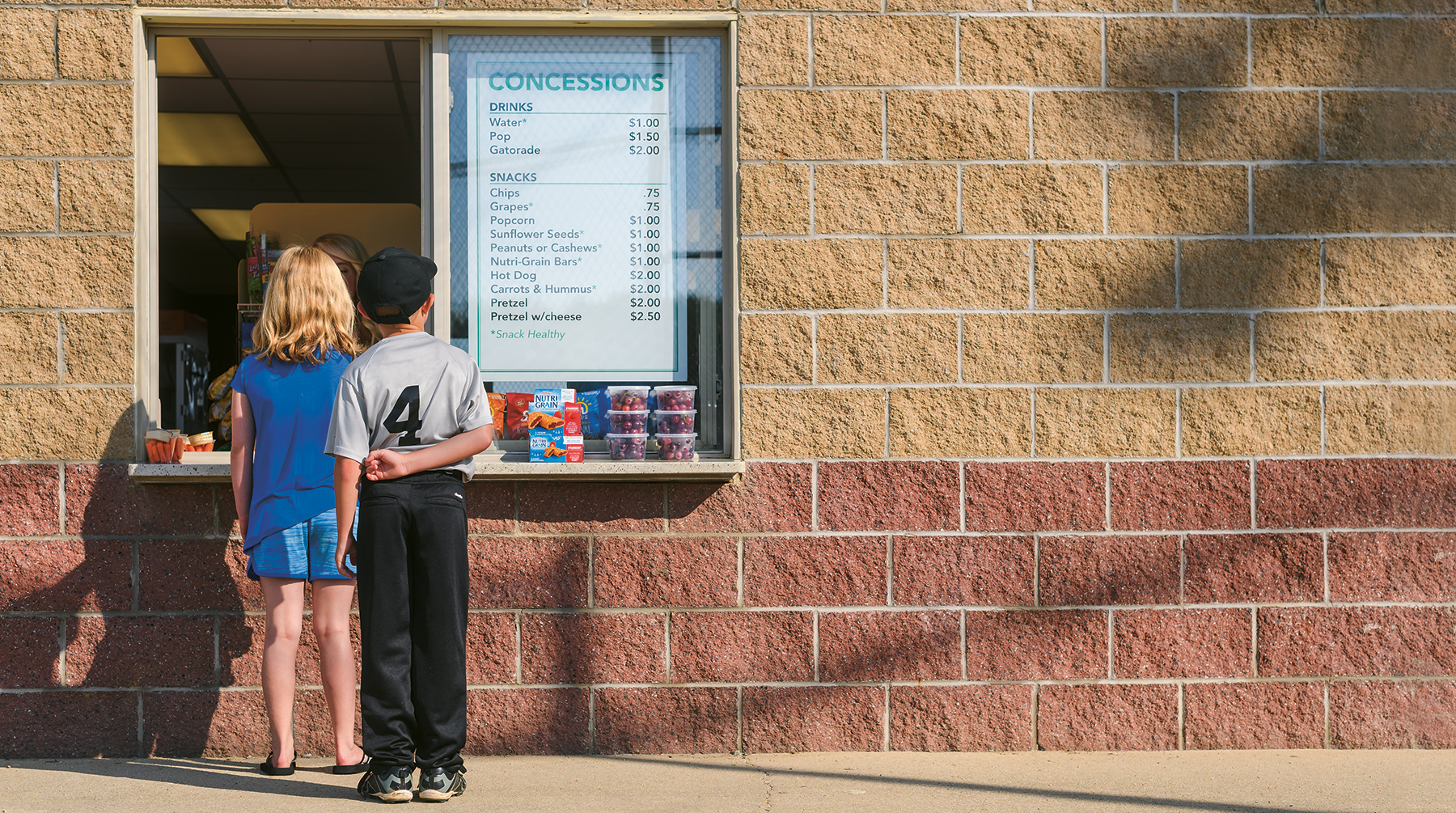Reducing Obesity and Improving Lives One Community at a Time
Story by Becky Brown, Photo By Rebecca Wilcox
It’s no secret that obesity has reached epidemic levels in the United States — driving up health care costs by the billions and driving down quality of life for millions. Could one secret to tackling the problem lie in community-based prevention?
Experts from the College of Health and Human Sciences are testing this idea through a new project implemented in two rural Indiana counties. What they have learned is this: Though reducing obesity rates takes time, changing attitudes and actions about healthy living happens quickly when local residents are empowered to identify and implement their own solutions.
 In 2016 the CDC put out a nationwide call to universities to partner with their cooperative extension service programs to reduce adult obesity in counties with obesity rates above 40%.
In Indiana, that included Jackson and Lawrence counties.
In 2016 the CDC put out a nationwide call to universities to partner with their cooperative extension service programs to reduce adult obesity in counties with obesity rates above 40%.
In Indiana, that included Jackson and Lawrence counties.
Obesity by the numbers
According to the latest U.S. Centers for Disease Control and Prevention statistics, the prevalence of obesity among U.S. adults is now at 39.8% — affecting 93.3 million people. It’s a major contributor to heart disease, Type 2 diabetes, stroke, cancer and hypertension, resulting in annual medical costs of $147 billion. These health issues have a significant economic effect, too. A study recently published in the Journal of Occupational and Environmental Medicine estimates that obesity-related absenteeism costs the nation’s businesses $8.65 billion a year.
In Indiana, the numbers aren’t any better. In 2018, the United Health Foundation, which compiles national health data, ranked the state 39th in both obesity percentage and lack of physical activity among adults and 48th in state and federal dollars spent on public health.
A 2019 report from the Richard M. Fairbanks Foundation, an Indianapolis nonprofit, found that eight in 10 Indiana adults don’t get enough physical activity and nine in 10 don’t eat the recommended amount of fruits and vegetables — both leading causes of obesity. The study says absenteeism, productivity declines, rising health care costs and lost economic output caused by obesity are costing the state billions annually.
“The consequences of not addressing this issue are going to lead to a host of chronic disease issues, poor quality of life and ultimately shorter lives,” says Tim Gavin, professor and head of the Department of Health and Kinesiology, who co-leads the community-based prevention project. “We can’t treat our way out of obesity — we must work to prevent it.”
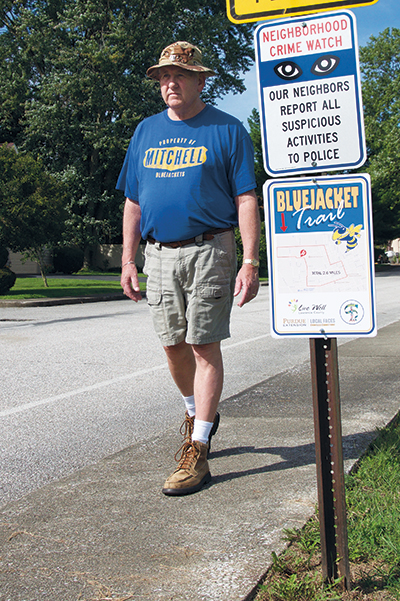 David Watson of Mitchell, Indiana, walks the Bluejacket Trail in Lawrence County. (Photo by Joan Crow)
David Watson of Mitchell, Indiana, walks the Bluejacket Trail in Lawrence County. (Photo by Joan Crow)
Boots-on-the-ground approach
An opportunity to partner with communities on prevention presented itself in 2016, when the CDC put out a call to universities nationwide asking them to partner with their cooperative extension service programs to reduce adult obesity in counties with obesity rates above 40%. In Indiana, that included Jackson and Lawrence counties.
Gavin teamed up with Angela Abbott, assistant dean in the college and associate director of HHS Extension, to respond to the CDC’s request. The CDC awarded them a two-year $1.15 million grant for their project titled, “Reducing Obesity in Indiana Through Community Involvement to Increase Prevention.”
Gavin and Abbott didn’t waste any time reaching out to community members. In fact, even before they formally applied for the grant, they worked with Purdue HHS Extension staff embedded in the counties to bring on board two existing organizations: Healthy Jackson County and Live Well Lawrence County.
“We wanted to learn from them first, because they know best what’s working, what’s not working and what partnerships are already in place,” Abbott says. “We did not want to take the approach of the big university coming in and telling the community what to do.”
That’s a common mistake, according to Pam Aaltonen, Purdue professor emerita of nursing, who now serves as president of the American Public Health Association.
“Too often in the past, we’ve designed programs, brought them to a community, implemented them and then left. When you do that, you don’t build anything that will sustain once you’re gone,” she says. “This project took a different track, thanks to the collaboration with established HHS Extension offices in both counties. It’s the approach we need to take to effect real change in the health of communities.”
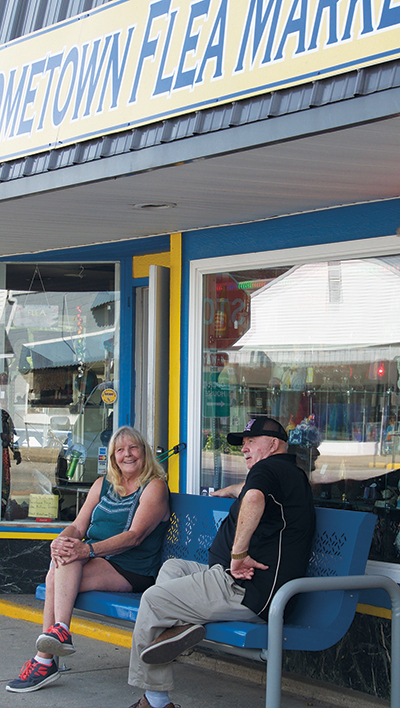 A stop on the Bluejacket Trail in Lawrence County. (Photo by Joan Crow)
A stop on the Bluejacket Trail in Lawrence County. (Photo by Joan Crow)
Building community coalitions
With community partners identified, Gavin and Abbott hit the ground running as soon as the grant was awarded. They assembled a team composed primarily of HHS Extension nutrition, health education and community development experts and used some of the grant money to hire community champions dedicated full-time to the obesity project.
Team members worked with Healthy Jackson County, Live Well Lawrence County, elected officials and volunteers to establish community coalitions that facilitated sessions in which local residents worked together to determine what was driving obesity in their communities and how best to address it. The remainder of the CDC grant money was used to implement the solutions they identified.
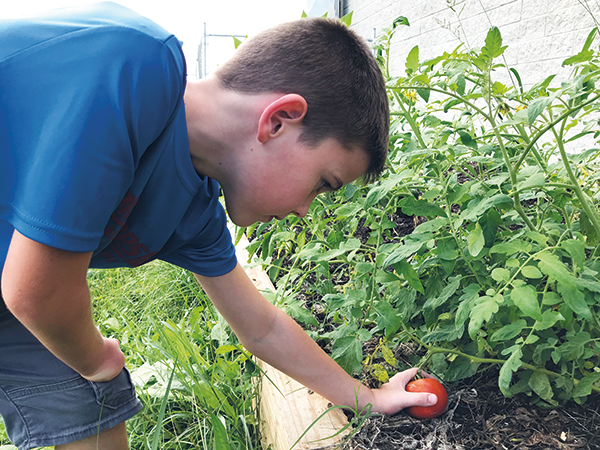 A community vegetable garden in Jackson County. (Photo by Joan Crow)
A community vegetable garden in Jackson County. (Photo by Joan Crow)
“The breadth of people who came together was amazing — elected officials, county health folks, even retirees,” Gavin says. “It just snowballed, and they quickly saw ways to make cost-effective changes that could have a big impact.”
Those changes included simple ways to increase physical activity and access to healthy foods, which can be challenging in rural areas where poverty rates are high, availability of fresh fruits and vegetables is low, and finding a sidewalk or shoulder on which to walk, run or ride a bike is difficult.
“So much of the work we see done in the area of health and obesity happens in urban and suburban settings,” Aaltonen says. “One of the nice things about this project is that it addresses issues that we see in rural communities across the country.”
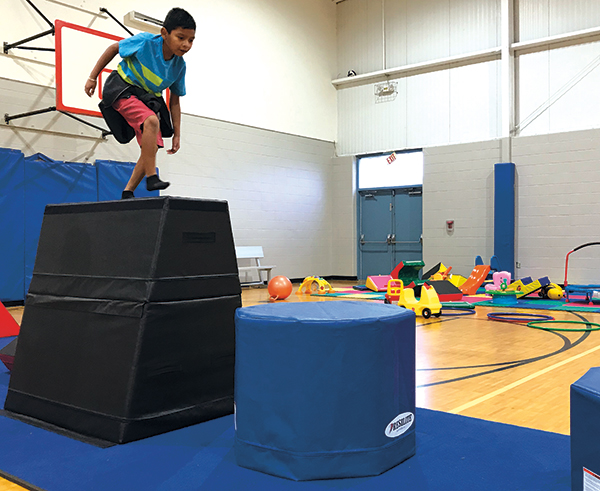 The Boys & Girls Club indoor playground in Jackson County. (Photo by Joan Crow)
The Boys & Girls Club indoor playground in Jackson County. (Photo by Joan Crow)
Making the healthy choice the easy choice
Communities in both counties added bike lanes, improved crosswalks, installed fitness equipment and otherwise found ways to make it easy and safe for residents to get active. Lawrence County, for example, created the Bluejacket Trail by connecting 2.6 miles of existing walkways.
“The Bluejacket Trail has two pluses,” says David Watson, a local resident who uses the trail often. “One is the physical activity and the other is the bonus of being able to reconnect with people I haven’t seen who are now on the trail.”
In Jackson County, the Boys & Girls Club of Seymour built an indoor playground for young children to use in the mornings, which then becomes a “ninja warrior course” for older kids the rest of the day.
“We’re already seeing over 40 families come on a regular basis,” says Ryon Wheeler, the organization’s executive director. “When it’s rainy and cold, they can come inside and find healthy outlets to continue to be active.”
To promote healthier eating, several communities established vegetable gardens, including one in Mitchell with raised beds and accessible paths for those in wheelchairs. In Seymour, the Boys & Girls Club added healthier choices to its vending machines, and the parks and recreation department took that a step further, requiring vendors at local concession stands to provide healthy options.
“We bid out that process so we wanted a policy change that says if you get this contract, you have to serve so many healthy items,” says Bob Tabeling, parks and recreation director.
Making it easier for people to make healthier choices sounds simple, but it’s a critical step in obesity prevention, Gavin says.
“What these communities were successful in doing was moving healthier options to the front and making them affordable,” he says. “Concession-stand operators agreed to sell water at a lower price than other drinks, which made water a cost-effective solution compared with soda.”
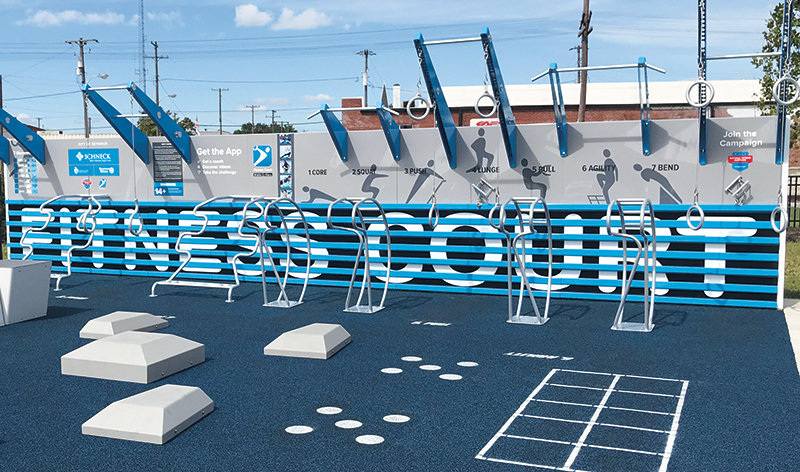 Outdoor exercise equipment in Jackson County. (Photo by Joan Crow)
Outdoor exercise equipment in Jackson County. (Photo by Joan Crow)
New connections, positive steps forward
Though it’s too soon for the data to show obesity rate reductions in Jackson and Lawrence counties, Gavin and Abbott shared some early successes during an HHS Learn & Lunch presentation in November 2018. Through Purdue HHS Extension, they’ll continue to track progress and provide support.
“We’ll follow up to make sure these groups are still together, working on their action plans and adjusting course when necessary,” Abbott says. “For us, a win is keeping these health coalitions sustained over time.”
Community leaders are eager to keep moving forward as well.
“With the relationship we’ve developed with Purdue Extension and the city park board, we have seen a larger number of people outside using the Bluejacket Trail, going to the parks, taking breaks on the benches and using the bike racks,” says J.D. England, mayor of Mitchell. “We just hope that number continues to grow.”
For Gavin, the obesity project represented his first time working closely with Purdue HHS Extension, and it opened his eyes to the role the organization plays in local communities.
“Purdue Extension is a connector,” he says. “I was impressed with how trusted a partner they are.”
Abbott looks forward to continuing to make those connections, both on and off campus.
“When you take the world-class research and faculty we have here on campus and bring that to local communities, you can do great things,” she says. “This project is a perfect example of how we connect research with community assets to make lives better."
Dorothy Teegarden, professor of nutrition science and former HHS associate dean for research and graduate programs, led a team of obesity experts that created an online resource to help students, teachers and the general public learn more about childhood obesity and obesity prevention.
The Transdisciplinary Obesity Prevention Research Sciences website includes 10-minute video micro-lectures designed to provide an overview of topics related to obesity prevention. The curriculum is a “flip-the-classroom” format and the site offers 29 course modules covering topics relevant to obesity. Topics include epigenetics, feeding practices in the child care environment, family mealtimes, federal food policy and culturally tailored interventions. In addition to the micro-lectures, the site provides test questions, class activities and optional readings to inform the public or for instructors to use in a course.
The collaborative project was produced by Purdue University, University of Illinois at Urbana-Champaign and California State University, Fresno, and funded by the USDA. The website is housed at Purdue’s STEM edHUB.
More Life 360 Stories
Milestones
Students
- Dean’s Message
- Speak Up
- Soccer and Scientists
- A Call to Nursing
- Upgrade
- "What was a GIANT LEAP in your life?"
Faculty
- Dean’s Message
- Speak Up
- Your Friends at Your Fingertips
- Environment for Obesity
- Getting and Early Start on Success
- Beyond 'You are What You Eat'
- Tracking Fat from Digestion to Delivery
- Reducing Obesity and Improving Lives One Community at a Time
- Is Your Drinking Water Safe?
- "What was a GIANT LEAP in your life?"
Alumni
- Dean’s Message
- Breaking the Silence
- A Whole New World
- Grady Eifert
- Giant Leaps Series
- Upgrade
- Hello!
- "What was a GIANT LEAP in your life?"

